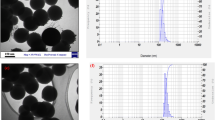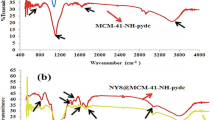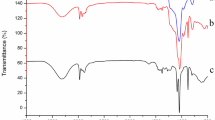Abstract
This paper investigates the antimicrobial potential of nanostructured mesoporous silica (NMS) functionalized with essential oils (EOs) and antibiotics (ATBs). The NMS networks were obtained by the basic procedure from cetyltrimethylammonium bromide and tetraethyl orthosilicate in the form of granules with diameters ranging from 100 to 300 nm with an average pore diameter of 2.2 nm, as confirmed by the BET–TEM analyses. The Salvia officinalis (SO) and Coriandrum sativum (CS) EOs and the streptomycin and neomycin ATBs were loaded in the NMS pores. TG analysis was performed in order to estimate the amount of the entrapped volatile EOs. The results of the biological analyses revealed that NMS/SO and NMS/CS exhibited a very good antimicrobial activity to an extent comparable or even superior to the one triggered by ATB, and a good in vitro and in vivo biocompatibility. Due to their regular pores, high biocompatibility, antimicrobial activity, and capacity to stabilize the volatile EOs, the obtained NMS can be used as an efficient drug delivery system for further biomedical applications.









Similar content being viewed by others
References
Anghel I, Grumezescu AM, Anghel AG, Chireac I, Marutescu L, Mihaiescu DE, Chifiriuc MC (2012) Antibiotic potentiator effect of the natural and synthetic zeolites with well defined nanopores with possible ent clinical applications. Farmacia 60:5
Anghel I, Grumezescu AM, Holban AM, Ficai A, Anghel AG, Chifiriuc MC (2013a) Biohybrid nanostructured iron oxide nanoparticles and Satureja hortensis to prevent fungal biofilm development. Int J Mol Sci 14:18110–18123
Anghel I, Holban AM, Andronescu E, Grumezescu AM, Chifiriuc MC (2013b) Efficient surface functionalization of wound dressings by a phytoactive nanocoating refractory to Candida albicans biofilm development. Biointerphases 8:12
Anghel I, Grumezescu AM, Holban AM, Gheorghe I, Vlad M, Anghel GA, Balaure PC, Chifiriuc CM, Ciuca IM (2014) Improved activity of aminoglycosides entrapped in silica networks against microbial strains isolated from otolaryngological infections. Farmacia 62:1
Arean CO, Vesga MJ, Parra JB, Delgado MR (2013) Effect of amine and carboxyl functionalization of sub-micrometric MCM-41 spheres on controlled release of cisplatin. Ceram Int 39:7407–7414
Assay Guidance Manual (2013).Cell Viability Assays Terry L Riss, PhD, Richard A Moravec, BS, Andrew L Niles, MS, Helene A Benink, Ph.D., Tracy J Worzella, MS, and Lisa Minor, Ph.D. Published May 1
Balaure PC, Andronescu E, Grumezescu AM, Ficai A, Huang K-S, Yang C-H, Lin Y-S, Chifiriuc CM (2013) Fabrication, characterization and in vitro profile based interaction with eukaryotic and prokaryotic cells of alginate-chitosan-silica biocomposite. Int J Pharm 441:555–561
Bariana M, Aw MS, Kurkuri M, Losic D (2013) Tuning drug loading and release properties of diatom silica microparticles by surface modifications. Int J Pharm 443:230–241
Benhamou A, Basly JP, Baudu M, Derriche Z, Hamacha R (2013) Amino-functionalized MCM-41 and MCM-48 for the removal of chromate and arsenate. J Colloid Interface Sci 404:135–139
Berlier G, Gastaldi L, Sapino S, Miletto I, Bottinelli E, Chirio D, Ugazio E (2013) MCM-41 as a useful vector for rutin topical formulations: synthesis, characterization and testing. Int J Pharm 457:177–186
Cao ZX, You JM, Li SX, Zhang YL (2012) Antimicrobial Activity of the Extracts from Coriandrum sativum. Int J Food Nutr Saf 1:54–59
Chen F, Huang L, Yang X, Wang Z (2013) Synthesis of Al-substituted MCM-41 and MCM-48 solid acids with mixed cationic–anionic surfactants as templates. Mater Lett 109:299–301
Chifiriuc MC, Grumezescu V, Grumezescu AM, Saviuc CM, Lazar V, Andronescu E (2012) Hybrid magnetite nanoparticles/Rosmarinus officinalis essential oil nanobiosystem with antibiofilm activity. Nanoscale Res Lett 7:209
Grumezescu AM (2013) Essential oils and nanotechnology for combating microbial biofilms. Curr Org Chem 17:90–96
Grumezescu AM, Chifiriuc CM, Marinas I, Saviuc C, Mihaiescu D, Lazar V (2012a) Ocinum basilicum and Mentha piperita essential oils influence the antimicrobial susceptibility of Staphylococcus aureus strains. Lett Appl NanoBioSci 1:14–17
Grumezescu AM, Chifiriuc MC, Saviuc C, Grumezescu V, Hristu R, Mihaiescu D, Stanciu GA, Andronescu E (2012b) Hybrid nanomaterial for stabilizing the antibiofilm activity of Eugenia carryophyllata essential oil. IEEE Trans Nanobiosci 11:360–365
Grumezescu AM, Andronescu E, Ficai A, Voicu G, Cocos O, Chifiriuc MC (2013a) Eugenia cayophyllata essential oil-SiO2 biohybrid structure for the potentiation of antibiotics activity. Rom J Mater 43:160–166
Grumezescu AM, Andronescu E, Grumezescu V, Bleotu C, Saviuc C, Mihaiescu DE, Chifiriuc CM (2013b) Biocompatible magnetic hollow silica microspheres for drug delivery. Curr Org Chem 17:1029–1033
Grumezescu AM, Andronescu E, Holban AM, Ficai A, Ficai D, Voicu G, Grumezescu V, Balaure PC, Chifiriuc MC (2013c) Water dispersible cross-linked magnetic chitosan beads for increasing the antimicrobial efficiency of aminoglycoside antibiotics. Int J Pharm 454:233–240
Grumezescu V, Holban AM, Iordache F, Socol G, Mogoşanu GD, Grumezescu AM, Ficai A, Vasile BS, Truşcă R, Chifiriuc MC, Maniu H (2014) MAPLE fabricated magnetite@eugenol and (3-hidroxybutyric acid-co-3-hidroxyvaleric acid)–polyvinyl alcohol microspheres coated surfaces with anti-microbial properties. Appl Surf Sci 306:16–22
Holban AM, Chifiriuc MC, Cotar AI, Bleotu C, Grumezescu AM, Banu O, Lazar V (2013a) Virulence markers in Pseudomonas aeruginosa isolates from hospital-acquired infections occurred in patients with underlying cardiovascular disease. Rom Biotehnol Lett 18:8843–8854
Holban AM, Cotar AI, Chifiriuc MC, Bleotu C, Banu O, Lazar V (2013b) Variation of virulence profiles in some Staphylococcus aureus and Pseudomonas aeruginosa stains isolated from different clinical patients. Afr J Microbiol Res 7:3453–3460
Holban AM, Grumezescu AM, Cartelle Gestal M, Mogoantă L, Mogoşanu GD (2014) Novel drug delivery magnetite nano-systems used in antimicrobial therapy. Curr Org Chem 18:185–191
Hudson SP, Padera RF, Langer R, Kohane DS (2008) The biocompatibility of mesoporous silicates. Biomaterials 29:4045–4055
Istrate CM, Holban AM, Grumezescu AM, Mogoantă L, Mogoşanu GD, Savopol T, Moisescu M, Iordache M, Vasile BS, Kovacs E (2014) Iron oxide nanoparticles modulate the interaction of different antibiotics with cellular membranes. Rom J Morphol Embryol 55(3):849–856
Kalbasi RJ, Mosaddegh N (2011) Synthesis and characterization of poly(4-vinylpyridine)/MCM-48 catalyst for one-pot synthesis of substituted 4H-chromenes. Catal Commun 12:1231–1237
Kaya DA, Vuluga Z, Nicolae CA, Radovici C, Albu MG (2013) The properties of two natural zeolites modified with oregano essential oil. Rom J Mater 43:48–54
Kim W et al (2013) Spaceflight promotes biofilm formation by Pseudomonas aeruginosa. In Beloin, Christophe. PLoS One 8:e6237
Li P, Xiong G, Liu L, Wang L (2013) Investigation on the effect of zeolite precursor on the formation process of MCM-41 containing zeolite Y building units. Spectrochim Acta Part A 107:218–226
Mihaiescu DE, Cristescu R, Dorcioman G, Popescu C, Nita C, Socol G, Mihailescu I, Grumezescu AM, Tamas D, Enculescu M, Negrea RF, Ghica C, Chifiriuc C, Bleotu C, Chrisey DB (2013) Functionalized magnetite silica thin films fabricated by MAPLE with antibiofilm properties. Biofabrication 5:015007
Miladinovi D, Miladinović L (2012) Antimicrobial activity of essential oil of sage from Serbia. Facta Univ Ser 2:97–100
Mogoşanu GD, Popescu FC, Busuioc CJ, Lascăr I, Mogoantă L (2013) Comparative study of microvascular density in experimental third-degree skin burns treated with topical preparations containing herbal extracts. Rom J Morphol Embryol 54:107–113
Poole K (2004) Efflux-mediated multiresistance in gram-negative bacteria. Clin Microbiol Infect 10:12–26
Qiang Z, Bao X, Ben W (2013) MCM-48 modified magnetic mesoporous nanocomposite as an attractive adsorbent for the removal of sulfamethazine from water. Water Res 47:4107–4114
Roik NV, Belyakova LA (2013) Sol–gel synthesis of MCM-41 silicas and selective vapor-phase modification of their surface. J Solid State Chem 207:194–202
Saviuc C, Marinas I, Grumezescu AM, Bleotu C, Chifiriuc C, Mihaiescu D, Lazar V (2012) Phytochemical composition of the fennel fruits essential oil and its influence on prokaryotic cells growth and pathogenic features. Biointerface Res Appl Chem 2:300–305
Saviuc C, Cotar AI, Holban AM, Banu O, Grumezescu AM, Chifiriuc MC (2013) Phenotypic and molecular evaluation of Pseudomonas aeruginosa and Staphylococcus aureus virulence patterns in the presence of some essential oils and their major compounds. Lett Appl NanoBioSci 2:91–96
Tacconelli E, De Angelis G, Cataldo MA, Pozzi E, Cauda R (2008a) Does antibiotic exposure increase the risk of methicillin-resistant Staphylococcus aureus (MRSA) isolation? A systematic review and meta-analysis. J Antimicrob Chemother 61:26–38
Tacconelli E, De Angelis G, Cataldo MA, Pozzi E, Cauda R (2008b) Does antibiotic exposure increase the risk of methicillin-resistant Staphylococcus aureus (MRSA) isolation? A systematic review and meta-analysis. J Antimicrob Chemother 61(1):26–38. doi:10.1093/jac/dkm416
Voicu G, Grumezescu V, Andronescu E, Grumezescu AM, Ficai A, Ghitulica CD, Gheorghe I, Chifiriuc MC (2013) Caprolactam-silica network, a strong potentiator of the antimicrobial activity of kanamycin against Gram-positive and Gram-negative bacterial strains. Int J Pharm 446:63–69
Voicu G, Anghel AG, Badea M, Bordei E, Crantea G, Gavrila RI, Grecu A, Jercan DAM, Nicolae BC, Vochitoaia GC, Tchinda K, Holban AM, Bleotu C, Grumezescu AM (2014) Silica network improve the effect of fludarabine and paclitaxel on HCT8 cell line. Rom J Morphol Embryol 55:545–551
Xu W, Riikonen J, Lehto V-P (2013) Mesoporous systems for poorly soluble drugs. Int J Pharm 453:181–197
Yan M, Pamp SJ, Fukuyama J, Hwang PH, Cho DY, Holmes S, Relman DA (2013) Nasal microenvironments and interspecific interactions influence nasal microbiota complexity and S. aureus carriage. Cell Host Microbe 14:631–640
Acknowledgments
This research was financially supported by Sectoral Operational Programme Human Resources Development, financed from the European Social Fund and by the Romanian Government under the contract number POSDRU/156/1.2/G/135764. Improvement and implementation of university master programs in the field of Applied Chemistry and Materials Science-ChimMaster.
Author information
Authors and Affiliations
Corresponding author
Rights and permissions
About this article
Cite this article
Voicu, G., Dogaru, I., Meliţă, D. et al. Nanostructured mesoporous silica: new perspectives for fighting antimicrobial resistance. J Nanopart Res 17, 201 (2015). https://doi.org/10.1007/s11051-015-3004-7
Received:
Accepted:
Published:
DOI: https://doi.org/10.1007/s11051-015-3004-7




